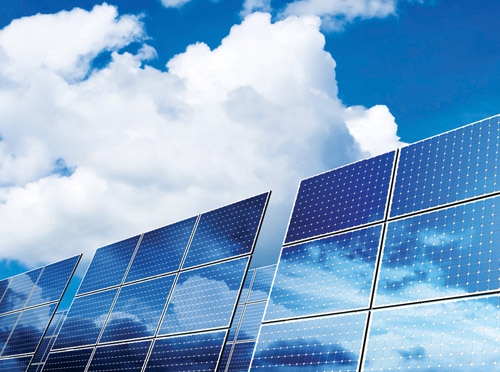Talking about the pros of solar PV systems, Stefan de Haan, principal analyst, Photovoltaics, IHS iSuppli, says, “In most regions of the world, PV is already the cheapest renewable energy technology. The learning curve is steeper than for any other technology. The competitive edge will further increase. From the perspective of a private end-consumer, the advantages are obvious: Local electricity generation, independence from utilities and cost saving.”
According to Debasish Paul Choudhury, president, SEMI India, the biggest advantage of a solar PV system is that it lends itself nicely toward the decentralised power generation, i.e., it can work equally well in a grid-connected or an off-grid mode at any scale, be it small (kW scale) or large (MW scale). The other advantage of solar PV systems is that there are very few mechanical components associated with these, which greatly improves the longevity while keeping the operational and maintenance cost low.

As for the cons, Choudhury shares that presently, solar is very expensive amongst the slew of available renewable energy technologies. However, it is slowly overcoming this disadvantage with prices falling every day.
Stefan de Haan adds, “PV requires a significant upfront investment that pays back on a timescale of five to 20 years. Storage solutions, smart grid, etc are required to enable PV to become the dominant source of electricity.”
Payback and degradation
A large area of unshaded south, south-west or south-east facing roof is required to maximise payback. Smaller systems can be installed, but the payback period could be longer.
“It is just a question of price. In many cases, PV offers highly attractive returns also on west- and east-facing roofs. With cost and price further declining, this will improve,” shares Stefan de Haan.
East- and west-facing modules offer the advantage of producing electricity in the morning and evening, respectively—a time when the majority of PV systems generate small output. Electricity prices at noon will be lower, and this fact can make east- and west-facing roofs economically interesting.
S.S. Raghunandan, vice president-Engineering, Kotak Urja, emphasises that the installation has to be done at the right location in order to maximise the power generation.
“It is not just about payback. It is about performance. The solar modules have to face the sun as much as possible. To do this, you would need to choose a place and direction which can maximise harvesting of solar energy,” he adds.
Solar panels generally degrade over time by approximately 20 per cent over a period of 25 years.
“PV modules generally have a very long life and strong weather resistance. They are built for a long life of over 25 years, though there is some loss of power production within the lifetime,” shares Raghunandan.
Stefan de Haan informs, “A typical warranty guarantees at least 80 per cent of the output after 25 years, while some others offer more. There are clear indications that for many products, degradation is significantly smaller than that. Lifetimes of 40 years are not out of reach.”
“Much like other goods, wear and tear causes the equipment to degrade over time. There is very little that can be done other than to improve standards of construction so as to ensure that the degradation is kept to a minimum,” shares Choudhury.
“A lifespan of 20-25 years is generally considered very good when you look at the low maintenance requirement for these systems,” he adds.
The electronics parts, though, would require some kind of replacements or repairs as they are not made to sustain such a long-term operation. So is it beneficial to replace the solar inverter after, say, ten years to optimise power generation?
According to Stefan de Haan, this depends heavily on the concrete installation. Intelligent monitoring systems will prove very useful. However, this field is just starting.
Fitting PV in felted flat roof
Another point to consider is “how easy or difficult is it to fit PVs to a large area of felted flat roof?”
The building architectures can be retrofitted with solar panels subject to their orientation and solar PV technology. “Crystalline must be installed in a shadow-free area and thin film can work even under shadowed conditions. Building-integrated PV (BIPV) provides various approaches in this,” shares Raghunandan.
According to Raghunandan, BIPV offers a host of benefits, such as energy production, energy demand management and substitution of existing building material. Using BIPV, the materials become a building’s integral part. Electricity created by sunlight flows through the power conversion equipment and into a building’s electrical distribution system, feeding electricity to the building’s loads.
Thin-film BIPV is said to be the most suitable for grid interface. It provides uniform coloured transparent surfaces for high aesthetics. BIPV also helps to reduce carbon emission, besides being cheaper than other materials such as bronze and marble.
Special solutions exist for the vast majority of applications, although the cost can be higher.
As of now, solar PV panels cost more than solar thermal panels. Will this scenario change over time?
Choudhury explains: “Solar thermal systems do not use ‘panels’ per se. They use mirrors, usually, to focus the solar (heat) energy onto pipes that have a heat transfer fluid, which converts water into steam, thereby running a steam turbine. In other scenarios, the solar heat energy can be used to directly run a Sterling engine without the need for intermediate conversions.”
“Since the price of mirrors has largely remained the same, the price of solar PV panels (which contribute about 50 per cent to the project cost) has dropped significantly due to the global supply glut. This drop in price is due to a supply-demand mismatch rather than the cheapness of the technology as such,” he adds.
Further, considering that the global appetite for solar thermal is much lower than that for solar PV, there are very few players in that space and it is only logical that it will suffer from mismatches in economies of scale.
Raghunandan feels that it’s not right to compare solar PV and solar thermal. “Both are different approaches and have their own engineering approach. The conversion efficiency of PV is very less compared to thermal conversion efficiencies. In PV, only a part of sunlight can work in generation while the other is converted into heat or lost. So research work is going on toward building panels that can generate electricity and heat. The industry is still working in this direction,” he shares.
Stefan de Haan points out that concentrated solar power (large-scale solar thermal) has the potential to become cheaper than PV in the earth’s sunbelt. However, progress in the past years has been minimal. The technology is not yet mature and might not fulfil its promises. The progress of PV on the other hand is overwhelming.
“For typical residential rooftops, small-scale solar thermal is not cheaper than PV anymore. Not too far from today, it will even be the other way round: PV electricity will be used to heat water,” he adds.
Effectiveness of PV panels
Suppliers are actively working towards increasing the effectiveness of PV panels.
Raghunandan notes: “The crystalline efficiencies mostly depend on cell efficiency. At module level, we are only trying to see how we could reduce the temperatures of the modules to increase the efficiencies. The cell efficiencies have reached over 20 per cent and there is a possibility that these efficiencies would reach around 30 per cent in future.”
Therefore, can PV systems operate normally in grid-connected mode and still operate loads when the utility service is disrupted?
Choudhury answers: “Yes, they can operate normally in both modes. Modern inverters have controllers built into them that choose the cheapest source of electricity available at all times. Further, in the absence of the grid, the solar PV installation and loads are usually ‘islanded’ and the solar PV system proceeds to act much like a diesel generator.”
Raghunandan adds, “Grid-connected ones work only when the grid is available. For grid failure, we must go for off-grid type of systems.”
The key is cost-effective storage solutions, according to Stefan de Haan. That would solve many issues. “We see progress here, but it is still the one and only missing component,” he adds.
Finally, it will be interesting to note IHS iSuppli’s forecast for India for 2013. It expects the Indian market to surpass the gigawatt mark in 2012 and continue to grow strongly in the years after. About 1.7 GW is expected for 2013.
The author is an executive editor at EFY





